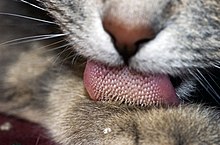Behavior
Free-ranging cats are active both day and night, although they tend to be slightly more active at night. The timing of cats' activity is quite flexible and varied, which means that house cats may be more active in the morning and evening (crepuscular behavior), as a response to greater human activity at these times. Although they spend the majority of their time in the vicinity of their home, housecats can range many hundreds of meters from this central point, and are known to establish territories that vary considerably in size, in one study ranging from 7 to 28 hectares (17 to 69 acres). Cats conserve energy by sleeping more than most animals, especially as they grow older. The daily duration of sleep varies, usually 12–16 hours, with 13–14 being the average. Some cats can sleep as much as 20 hours in a 24-hour period. The term "cat nap" for a short rest refers to the cat's tendency to fall asleep (lightly) for a brief period. While asleep, cats experience short periods of rapid eye movement sleep often accompanied by muscle twitches, which suggests that they are dreaming.
Although wildcats are solitary, the social behavior of domestic cats is much more variable and ranges from widely dispersed individuals to feral cat colonies that form around a food source, based on groups of co-operating females. Within such groups one cat is usually dominant over the others. Each cat in a colony holds a distinct territory, with sexually active males having the largest territories, which are about ten times larger than those of female cats and may overlap with several females' territories. These territories are marked by urine spraying, by rubbing objects at head height with secretions from facial glands, and by defecation. Between these territories are neutral areas where cats watch and greet one another without territorial conflicts. Outside these neutral areas, territory holders usually chase away stranger cats, at first by staring, hissing, and growling, and if that does not work, by short but noisy and violent attacks. Despite some cats cohabiting in colonies, cats do not have a social survival strategy, or apack mentality and always hunt alone.
Domestic cats use many vocalizations for communication, including purring, trilling, hissing, growling/snarling, grunting, and several different forms ofmeowing. By contrast, feral cats are generally silent. Their types of body language, including position of ears and tail, relaxation of whole body, and kneading of paws, are all indicators of mood. The tail and ears are particularly important social signal mechanisms in cats, e.g. with a raised tail acting as a friendly greeting, and flattened ears indicating hostility. Tail-raising also indicates the cat's position in the group's social hierarchy, with dominant individuals raising their tails less often than subordinate animals. Nose-to-nose touching is also a common greeting and may be followed by social grooming, which is solicited by one of the cats raising and tilting its head.
However, some pet cats are poorly socialized. In particular, older cats may show aggressiveness towards newly arrived kittens, which may include biting and scratching; this type of behavior is known as feline asocial aggression.
For cats, life in proximity to humans and other animals kept by them amounts to a "symbiotic social adaptation". They may express great affection towards their human (and even other) companions, especially if they psychologically imprint on them at a very young age and are treated with consistent affection. It has been suggested that, ethologically, the human keeper of a cat functions as a sort of surrogate for the cat's mother, and that adult housecats live their lives in a kind of extended kittenhood, a form of behavioral neoteny. It has even been theorized that the high-pitched sounds housecats make to solicit food may mimic the cries of a hungry human infant, making them particularly hard for humans to ignore.
Grooming
Cats are known for their cleanliness, spending many hours licking their coats. The cat's tongue has backwards-facing spines about 500 micrometers long, which are called papillae. These are quite rigid, as they contain keratin. These spines allow cats to groom themselves by licking their fur, with the rows of papillae acting like a hairbrush. Some cats, particularly longhaired cats, occasionally regurgitate hairballs of fur that have collected in their stomachs from grooming. These clumps of fur are usually sausage-shaped and about two to three centimeters long. Hairballs can be prevented with remedies that ease elimination of the hair through the gut, as well as regular grooming of the coat with a comb or stiff brush. Some cats can develop a compulsive behavior known as psychogenic alopecia, or excessive grooming.



Tidak ada komentar:
Posting Komentar